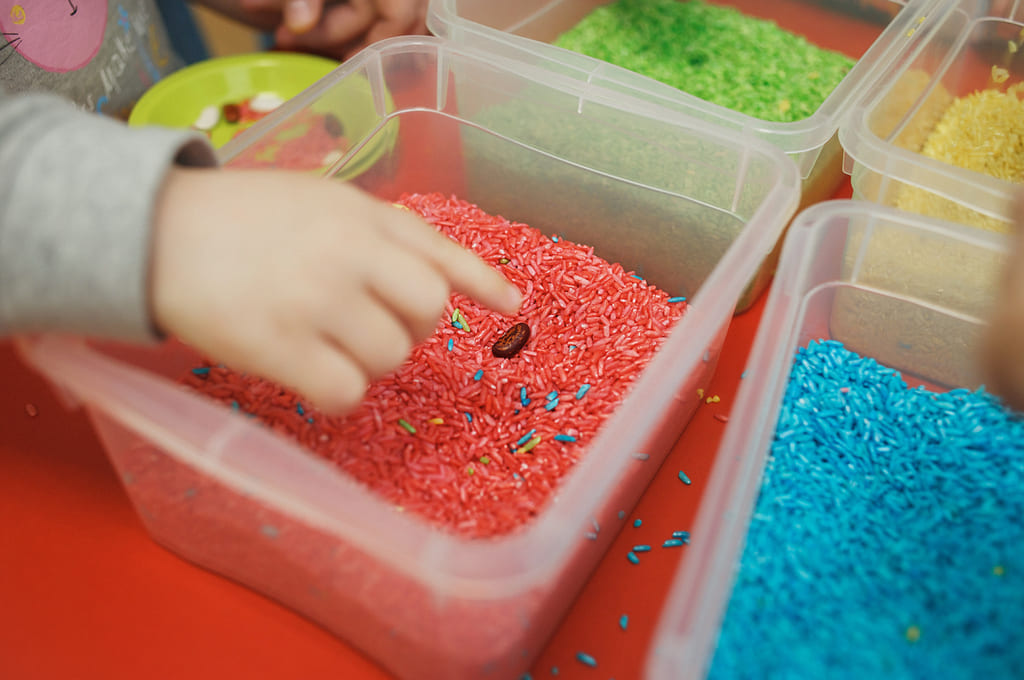If you are a regular follower of our blog (thank you!), you know we are firm believers that, as Fred Rogers famously said, “Play is the work of childhood”. Play is the way children learn to make sense of the world around them and their place in it. And one of the most engaging ways children can play and enjoy new experiences is by using sensory bins.
Today we’ll be explaining what sensory bins are and why they are so beneficial to young learners, and we’ll share a few fun sensory bin examples you can create at home.
What is a sensory bin?
A sensory bin is a shallow bin or container that is filled with various materials that children can use to explore. Children learn best when they are allowed to hold objects (or engage in tactile play) while using their senses.
Sensory bins can be filled with sand, rice, water, and other mediums, and they usually include other toys or accessories that can be used to interact with the filler—things like cups, spoons, and funnels.
As children play with a sensory bin, they are also using their senses to see, touch, hear, and smell…and they benefit from playing with sensory bins in 5 surprising ways.
What are the benefits of sensory bin play?
1. Sensory Stimulation
As children interact with the bin, multiple senses are engaged at once. They are seeing, hearing, feeling, and, in some cases, smelling simultaneously. Research has found that this type of stimulation forges new nerve pathways in the brains of children and paves the way for language development, cognitive growth, and better problem-solving skills.
2. Encourage Self-Regulation
Receiving information through the senses helps children understand body awareness in terms of their own movement and balance (also known as proprioception). As children interact with a sensory bin, they gain a better understanding of where their body parts are and how much of their own strength is required to move them.
3. Boost Fine Motor Skills
Fine motor skills are required to move the delicate muscles in the fingers, hands, and wrists, and it is important that preschoolers strengthen these muscles as they help children hold writing instruments and eating utensils, zip zippers, and button buttons.
As children interact with a sensory bin, they are often scooping material, stacking blocks, and holding cups—all of which help to build strong fine motor skills.
4. Promote Language Development
You might be surprised to learn that sensory bin play can have a positive effect on language development.
Many important concepts are learned while playing with a sensory bin—things like above/below, cold/warm, and smooth/bumpy among others. As children play, parents or caregivers can suggest alternate words for items found in the sensory bin.
I see you are holding a cup. Is that a red cup or a blue cup? Does the cup feel smooth or rough?
As you introduce new words to your child that relate to the sensory bin, their vocabulary grows in an effortless and organic way.
5. Boosts Socialisation
This is especially true if your child is playing with a sensory bin in a group setting. When this happens, children learn to take turns, work collaboratively, and problem-solve with one another. And it’s important to remember that socialisation can (and does) happen outside of a school setting. Your child can reap the socialisation benefits by playing with an at-home sensory bin alongside siblings and friends.
What are some examples of sensory bins I can create at home?
We’re glad you asked! Here are a few of our favorites:
Water Sensory Bin: What’s more fun than splashing in and manipulating water? Fill up a bin at home and offer your child scoops, cups, funnels, and syringes. Try a sink/float experiment by handing your child various objects like spoons (plastic and metal), corks, rocks, and plastic toy figures and asking them whether the object will sink or float when dropped in the bin. You can also experiment with different water temperatures.
If you’d like to incorporate smell into the water bin, try adding a few drops of an essential oil like lavender, orange, or peppermint.
Sand Sensory Bin: Though some people use dirt from their own yards, we suggest purchasing play sand from an educational supply store or online. You can also use kinetic sand that is somewhat moist and can be molded into various shapes.
Cinnamon Soap Foam Bin: If you want to engage your child’s sense of smell, try whipping up a batch of cinnamon soap foam. It ends up looking like sand, making it perfect for use with tractors and toy cars…and it smells incredible! One of the biggest benefits of sensory bin play is this—your child will have so much fun they won’t even realise they’re learning!











